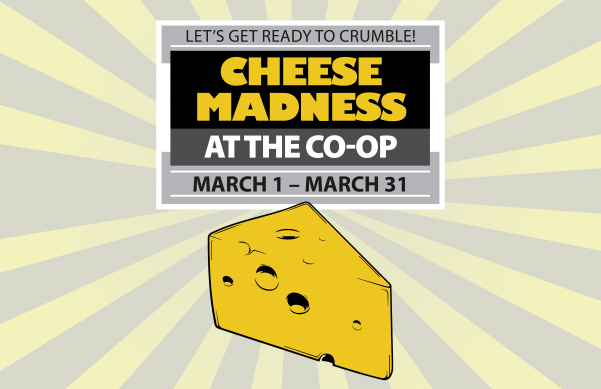Cheese Madness

8 cheeses will go rind-to-rind in the Co-op’s bracket challenge!
Grand Prize: $75 MFC Gift Card!
Sample and vote in-store March 7-29
Thursdays 11:00am-1:30pm
Fridays 3:30-5:30pm
2024 Lineup
P’tit Basque:
This small cylindrical sheep’s milk cheese is made in the Pyrenees Mountains, which straddle France and Spain. The area is known for its cheeses, most notably Ossau Iraty. Think of P’tit Basque as this cheese’s little brother. Traditionally, the cheese was made using leftover curd set aside after shepherds milked their ewes. Today, fresh ewe’s milk is used, but it’s still made by hand. The paste is smooth and creamy with hints of brown butter and caramel. While it’s typically eaten with black cherry jam, P’tit Basque is also great for cooking, shaved on top of grilled vegetables, or eaten alongside chorizo and marcona almonds.
Mimolette:
With a natural rind that resembles a cantaloupe and a paste the color of a pumpkin, aged Mimolette is made by forming the curd into a ball-shape, resting it in a salt bath for a few days, and then placing it on wooden boards to age in caves. It’s subtly fruity and slightly salty with notes of butterscotch and an aroma of hazelnut, with a brittle texture that resembles that of a very aged Gouda. Mimolette improves with age and is a great option for any cheeseboard, it pairs nicely with Chianti, Sangiovese, or brown ale.
Raclette:
Raclette is a semi-hard cow’s milk cheese from the Swiss Alps & Savoy region of France. Its name means “to scrape” as it’s melted & scraped onto bread or plates. Rich, creamy, & slightly nutty, Raclette pairs well with crusty bread, cured meats, vegetables, & wines like Chardonnay or Pinot Noir. Raclette is traditionally served by melting the cheese over a heat source, such as a fireplace or a special Raclette grill, and then scraping the melted layer onto individual plates or slices of bread. The melted cheese is typically accompanied by a variety of side dishes, such as cured meats, pickles, boiled or grilled vegetables, and potatoes. At home you can melt Raclette in a fondue pot, or in the oven at 200-250 degrees until it bubbles.
Blumenkaese:
An alpine cheese covered with wildflowers from the meadows of Switzerland, this floral beauty isn’t just pretty on the outside, it’s packed with flavors of French onion soup and sweet carrots. The long list of flowers and herbs that decorate the rind include winter savory, dill, garlic, caraway, lovage, marjoram, mint, leek, chive, parsley, juniper berries, onion, marigolds, cornflower, roses, strawberry leaves. This unique cheese pairs beautifully with crisp white wines, fresh fruits, and crusty bread, making it an ideal choice for a charcuterie board or light appetizer.
Quadrello di Bufala:
Quadrello di Bufala is a water buffalo milk cheese produced in the Lombardy region of Italy. Made from pasteurized milk, this washed-rind cheese is aged for about 40 days. Reminiscent of Taleggio, in both its shape and rind treatment, Quadrello di Bufala commands just as much attention as its cow’s milk counterpart. The sticky, semi-soft paste is sweet and grassy with an intriguing yeasty note. It’s pleasantly mild but packed with the thick cream flavors typically found in water buffalo cheeses. Pair with Riesling, Malbec, Cider, or a farmhouse ale.
Pecorino Romano:
The name of this cheese literally means “sheep cheese of Rome”. While perhaps less well known than Parmigiano Reggiano, this cheese is just as much a classic of the Italian repertoire and one of the country’s oldest cheeses. It’s hard, crumbly, nutty, and salty; an excellent grating cheese but good for snacking too. This is the traditional cheese to use for your carbonara and spaghetti alla cacio e pepe but it’s also great with potatoes and roasted vegetables or shaved over a salad. Chianti or Prosecco will pair well with this cheese but if you prefer beer try a light lager.
Tipperary Vintage Irish Cheddar:
The history of this cheddar can be traced back to the early 19th century, when Irish cheesemakers began to experiment with cheddar production techniques. The county of Tipperary has a long tradition of dairy farming and cheese production, with the region’s lush, green pastures providing ideal conditions for raising dairy cattle. Over time, the cheesemakers in Tipperary developed their own unique style of cheddar, which has become renowned for its depth of flavor and quality. This aged cheddar is a crowd-pleasing favorite; it pairs well with various foods and beverages, such as fruits, crackers or bread, charcuterie, Irish stouts or porters, and full-bodied red wines like Cabernet Sauvignon, Merlot, or Syrah. Try adding this cheddar to mashed potatoes or to top a shepherd’s pie.
Kerrygold Dubliner Cheddar:
Kerrygold is an Irish company with a long history of producing high-quality dairy products. The cheese is made from the milk of grass-fed cows, which contributes to its rich, creamy flavor. The use of traditional Irish cheesemaking techniques adds to the charm and appeal of the cheese. A mature, full-flavored cheese with a natural hint of sweetness, it has elements of a cheddar, the sweet nutty tones of a Swiss, and the piquant bite of an aged parmesan. Suitable for vegetarians, Dubliner can be used on a cheese board, in sandwiches, and in a range of recipes. Particularly delicious simply cut into cubes or sliced.

